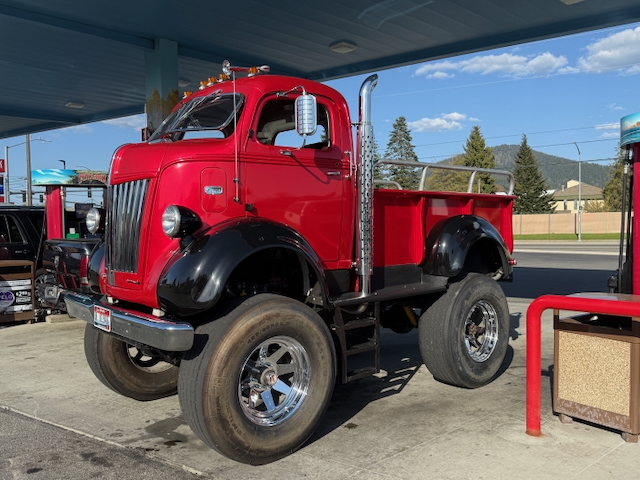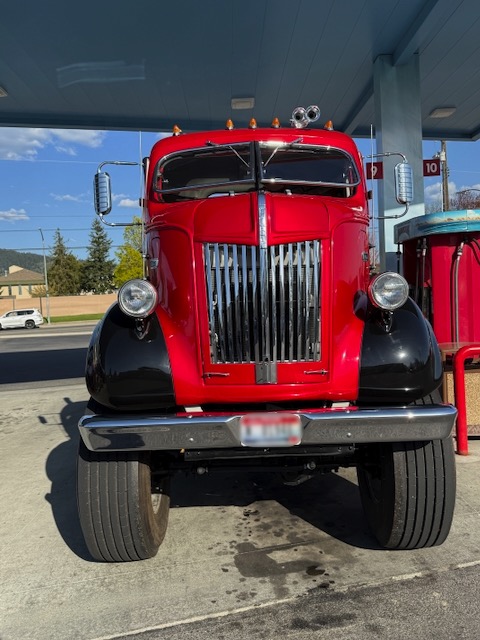
Posted on 04/25/2025 10:58:57 AM PDT by ProtectOurFreedom
I was getting gasoline yesterday in Coeur d'Alene, ID and this beauty was at the gas pump next to me. It's a rare 1940 Ford Cabover truck. The owner was a very nice young man who picked it up from a family friend after the guy who restored it passed away from a stroke. That gorgeous candy-apple red metal flake "paint" job is actually a wrap! In the 60s, the restorer / restomodder worked on cars in Southern California and he was able to buy two Ford 427 CI engines that had been custom made by Ford for drag racing. Only 100 of the engines were made.


I asked Grok about the 1940 Ford Cabover:
The 1940 Ford Cabover (COE, or Cab Over Engine) truck is a rare and iconic vehicle from Ford’s lineup, reflecting the Art Deco and Streamline Moderne styling of the late 1930s. Introduced in 1938, Ford’s COE design was innovative for its time, placing the cab directly above the engine to create a shorter wheelbase and tighter turning radius, ideal for navigating growing urban environments. Below is a general overview of the 1940 Ford COE truck, covering its design, specifications, historical context, and modern appeal, drawing on available information and addressing your interest in historical vehicles (as seen in your reference to Bonanza Railroads).The COE design positioned the driver above the engine, maximizing cargo space and maneuverability compared to conventional trucks with long hoods. This was a response to urban delivery needs, as cities expanded in the U.S. Styling: The 1940 Ford COE featured a distinctive, bulldog-like appearance with a rounded grille, vertical slats, and smooth, aerodynamic lines. Its Art Deco aesthetic included chrome accents, a tilt-out windshield, and optional roof-mounted horns. The design was considered futuristic, almost “space-age,” as noted in custom builds.
Many COEs were sold as chassis-cab units, allowing coachbuilders to create bespoke bodies (e.g., flatbeds, tankers, car haulers). This flexibility led to unique, low-production designs, often tailored to specific industries like fuel delivery or retail.
Stock interiors were utilitarian, with vinyl upholstery (often dark green), a simple dashboard, and manual controls.
Most 1940 Ford COEs were powered by Ford’s legendary flathead V8, a 239 cubic-inch L-head engine producing 95 horsepower. Some models used a 226 cubic-inch straight-six, rated at 90 hp, introduced in 1941 but available in trucks earlier. The flathead V8 was prized for reliability and became a hot-rod favorite. It was typically equipped with a 3-speed manual transmission, paired with a 2-speed rear axle for versatility in hauling. Built on a heavy-duty ladder frame, with leaf spring suspension front and rear. Custom restorations often swap in modern chassis (e.g., Chevy 1-ton) or air-ride systems for better handling.
Exact specs varied by body, but COEs had a compact wheelbase (100–130 inches) compared to conventional trucks, enhancing city agility. Gross vehicle weight ratings suited medium-duty tasks.
Ford’s COE, debuted in 1938 and was among the first factory-produced heavy-duty cabover trucks in the U.S., following pioneers like Autocar (1899) and White Motor Company (1930s). The design maximized payload in tight spaces, a game-changer for urban commerce.
COEs were special-use vehicles, produced in small numbers compared to Ford’s standard pickups. Few survive today, especially in original condition, due to heavy use and low production. Restored examples are prized by collectors.
The 1940 COE’s sleek design made it a commercial workhorse but also a style icon, used by companies for delivery, towing, or fuel transport (e.g., a 1940 COE Streamliner Fuel Tanker). Its Art Deco look later inspired hot-rodders and custom builders.
Well-preserved or restored 1940 Ford COEs are rare and valuable. A South Jersey Classics example won an Antique Automobile Club of America Senior National First Prize (2002) and the Early Ford V8 Club’s Dearborn Award, reflecting meticulous factory-spec restoration. Features like flathead V8s, chrome horns, and oak beds elevate value.
Many COEs are hot-rodded, as seen in Bob Dron’s 1940 COE (Classic Trucks Magazine, 2006), with a Chevy 355 small-block, Turbo 350 transmission, air-ride suspension, and 1939 Lincoln Zephyr headlights. Such builds blend vintage style with modern performance, though purists prefer stock.
Prices vary widely. Unrestored COEs can sell for $2,500–$7,000 (e.g., a 1940 COE on Kijiji, 2010), while restored or custom units fetch $45,000–$100,000+. Rarity and condition drive costs.
Their “weird” yet striking design, as noted on Reddit’s WeirdWheels, makes them stand out at car shows.
And I asked Grok about the engine:
The Ford 427 cubic-inch V8, part of the FE (Ford-Edsel) engine family introduced in 1958, was developed in 1963 as a racing powerhouse to dominate NASCAR, NHRA drag racing, and international competitions like Le Mans. While it saw street use (e.g., Galaxies, Cobras), Ford custom-built high-performance variants specifically for drag racing, where raw power and durability were paramount. The 427’s actual displacement was 425.98 cubic inches, but Ford branded it “427” to align with NASCAR’s 7-liter (427 cu in) limit, a marketing and regulatory nod. Ford produced several 427 configurations for drag racing, with the side-oiler and SOHC “Cammer” being the most iconic. These were engineered for NHRA’s Super Stock, A/Factory Experimental (A/FX), and Top Fuel classes, where Ford competed against Chrysler’s 426 Hemi and Chevy’s 409/427.
“385-series big block 7.5 liter V8”
More commonly, the 460.
Why didn’t someone didn’t put a standard height suspension and tires so it would be drivable?
~~~~~
The jack-up is required by the oversized tires combined with turning ability. I see maybe 5” of suspension throw, and that’s not excessive.
Leaving a normal body height would have required cutting out the body and wheel wells. Even then, that would have crowded the oversized engine.
...Compromises.
If the owner works hard and applies himself, he’ll be able to afford a new truck someday... :>)
Interesting that you saw that in Southern Oregon. The man who restored this Ford COE lived in Medford, OR. He had other collectible cars, too. The family put them up for auction in Grants Pass, OR after he passed away. I wonder if that gorgeous Chevy you show was owned by the same guy?!
The owner told me the family had no interest in carrying on Dad’s love affair with old cars so they sold off his collection. The cars should have gone to a big auction like at Sun Valley Resort (ID) or at Carmel. I can’t imagine there being much collectible car sales in Southern Oregon.
The owner is quite the entrepreneur. He bought a soap and body products company from the original founder who wanted to retire. He tripled sales in short order!
she’s a beauty...
LOL...;>)
Sure, I guess.
😊
It probably won’t remain at that displacement. I keep having visions of a stroker kit.
Thanks! Very cool.
Most similar trucks that I've seen customized go the opposite way - lowered with an air-ride adjustable suspension system, maybe with a retro tilt-bed rig on the back like a race team's car hauler. Shelby American used trucks like that to move Cobras around (those COE trucks were '60s vintage and boxier). Painted in race team colors, though.
Like the phone number right out of Hee Haw tv program.
My son and I were coming out of a shop and parked right in front of us was a fully-restored ‘56 Ford Thunderbird convertible with an elderly, distinguished, couple sitting in the car. He was playing the role to the hilt, with the Tam O’Shanter cap and driving gloves. I leaned over and whispered: “Don’t despair. I’ll bet someday he’ll be able to buy a new car for you to ride in.”
I think coffee came out her nose as she laughed! Him...not so much.
Sir Chode gets list credit for most of it for His F1 Ping List
My INDYCAR list is minimal.
Yup, they don’t make ‘Em like that anymore. Too bad cuz I think they could sell a bunch of that stuff but they only use one Wind Tunnel for public vehicles these days.
✅
That body was not made for tires that large.
I know nothing about cars and trucks. I do have an opinion ... that’s it’s really sad that newer vehicles have no character or uniqueness about them. They all look alike, and are boring. (IMO)
“They all look alike, and are boring”
It’s all the fault of the federal government and their CAFE mileage standards. They don’t want the peasants “wasting” gasoline even if they want to pay for it. The CAFE standards made every car look like an aerodynamic jelly bean.
When I was a kid in the 50s and 60s, every car was unique and distinct. Plus, the heavy hand of government didn’t weigh on you every single day.
If that guy has a 427 SOHC in that truck, WOW!!! Those engines were made to run on the race track and hate being on the street. But hold on if you hit the throttle because it’s going to light the tires.
....BRAKES....!!
Disclaimer: Opinions posted on Free Republic are those of the individual posters and do not necessarily represent the opinion of Free Republic or its management. All materials posted herein are protected by copyright law and the exemption for fair use of copyrighted works.